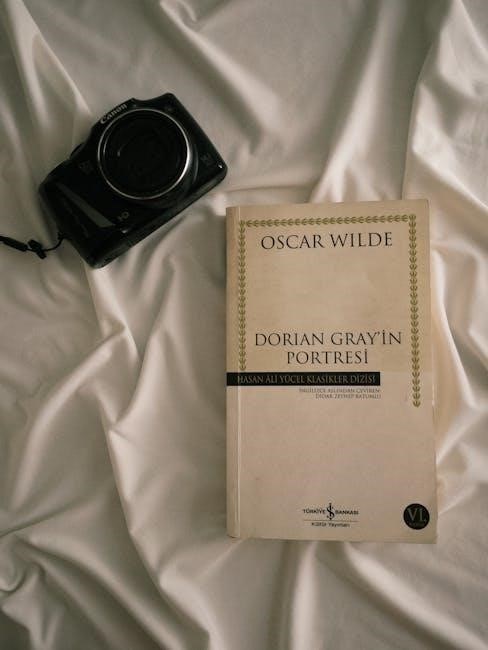Soundarya Lahari, authored by Adi Shankara and Pushpadanta, is a revered stotram in Hindu mythology, meaning “Waves of Beauty․” It is divided into Ananda Lahari and Soundarya Lahari, comprising 100 verses celebrating Goddess Lakshmi’s divine beauty and spiritual significance․ The Telugu version is widely cherished for its poetic elegance and theological depth, offering spiritual enlightenment and material prosperity to devoted readers․ Its availability in Telugu PDF format has made it accessible to millions, preserving its cultural and religious essence․
1․1 Overview of the Book
Soundarya Lahari, authored by Adi Shankara and Pushpadanta, is a sacred Hindu text divided into Ananda Lahari and Soundarya Lahari, comprising 100 verses․ It glorifies Goddess Lakshmi, emphasizing spiritual and material prosperity․ The Telugu PDF version is widely sought for its poetic beauty and theological depth, making it accessible to devotees while preserving its cultural and religious significance․
1․2 Meaning and Significance of Soundarya Lahari
Soundarya Lahari, meaning “Waves of Beauty,” is a hymn dedicated to Goddess Lakshmi, symbolizing divine beauty and spiritual enlightenment․ It explores the union of Shiva and Shakti, embodying theological depth and philosophical insights․ The text is revered for its poetic elegance and the spiritual and material prosperity it bestows on devotees, making it a cornerstone of Hindu worship and cultural heritage․
1;3 Importance of the Telugu Version
The Telugu version of Soundarya Lahari holds immense cultural and linguistic significance, preserving the stotram’s essence for Telugu-speaking devotees․ Its poetic beauty and clear translation make it accessible, fostering deep spiritual connection․ Widely popular, it bridges tradition and modernity, ensuring the divine hymns reach a broader audience while maintaining their sacred intent and emotional resonance․

Authorship and Historical Background
Soundarya Lahari, authored by Adi Shankara and Pushpadanta, is a poetic hymn dedicated to Goddess Lakshmi, blending spiritual and philosophical insights; Its historical significance is profound, and the Telugu PDF version enhances its accessibility for devotees․
2․1 Adi Shankara and His Contribution
Adi Shankara, a revered philosopher and poet, is credited with composing the initial verses of Soundarya Lahari․ His contribution includes blending devotion with philosophical insights, emphasizing the divine union of Shiva and Shakti․ The Telugu PDF version preserves his timeless work, making it accessible for spiritual seekers to recite and attain enlightenment․
2․2 Role of Pushpadanta in Soundarya Lahari
Pushpadanta, a celestial being, is believed to have contributed to Soundarya Lahari alongside Adi Shankara․ His verses highlight the divine beauty of Goddess Lakshmi, blending poetic elegance with spiritual depth․ The Telugu PDF version immortalizes his work, offering devotees a pathway to connect with the divine through heartfelt recitation and devotion․
2․3 Historical Context of the Stotram
Soundarya Lahari, composed by Adi Shankara and Pushpadanta, is a foundational text in Hindu spirituality, reflecting the philosophical and cultural milieu of its time․ Its creation is traced to the 8th century, embodying the essence of Shakti worship․ The stotram’s historical significance lies in its enduring popularity, particularly in Telugu-speaking regions, where it remains a revered devotional text, accessible now in Telugu PDF formats․

Structure and Content
Soundarya Lahari is structured into Ananda Lahari and Soundarya Lahari, comprising 100 verses․ It explores divine beauty and spiritual enlightenment, with key verses interpreted for theological depth and poetic brilliance;
3․1 Ananda Lahari and Soundarya Lahari
Soundarya Lahari is divided into two parts: Ananda Lahari (first 41 verses) and Soundarya Lahari (remaining 59 verses)․ Ananda Lahari focuses on the blissful union of Shiva and Shakti, while Soundarya Lahari glorifies Goddess Lakshmi’s divine beauty and grace․ Together, they form a poetic and theological masterpiece, exploring themes of devotion, spirituality, and the divine feminine, with profound philosophical insights woven into each verse․
3․2 Key Verses and Their Interpretations
Key verses in Soundarya Lahari reveal profound spiritual truths․ Shloka 1 invokes divine grace, while Shloka 41 marks a transition to deeper devotion․ Shloka 98, the climax, embodies enlightenment through union with the divine․ These verses symbolize the journey from devotion to spiritual awakening, highlighting the stotram’s theological depth and poetic beauty, making them central to its revered status in Hindu spirituality․
3․3 Theological Themes and Concepts
Soundarya Lahari explores the divine union of Shiva and Shakti, symbolizing cosmic harmony․ It delves into the nature of the ultimate reality, emphasizing the interplay of masculine and feminine energies․ The stotram also highlights the concept of the divine as both the creator and the creation, underscoring the path to spiritual enlightenment through devotion and the balance between material and spiritual wealth․
Theological Significance
Soundarya Lahari is a revered hymn celebrating Goddess Lakshmi’s divine beauty and grace․ It explores the interplay of Shiva and Shakti, blending devotion with philosophical insights, guiding seekers to spiritual enlightenment and material prosperity․
4․1 Worship of Goddess Lakshmi
Soundarya Lahari is a divine tribute to Goddess Lakshmi, embodying her celestial beauty and grace․ The stotram, dedicated to her worship, highlights her role as the embodiment of prosperity and divine energy․ Through its verses, devotees seek her blessings for spiritual growth and material abundance, reflecting the deep reverence for her divine presence in Hindu spirituality․
4․2 The Concept of Shiva and Shakti
Soundarya Lahari profoundly explores the union of Shiva and Shakti, symbolizing the divine harmony of masculine and feminine energies․ The stotram portrays Shakti as the dynamic force complementing Shiva’s transcendence, embodying the cosmic energy driving creation and sustenance․ This sacred union reflects the philosophical essence of non-duality, emphasizing their inseparability in achieving spiritual enlightenment and universal balance․
4․3 Philosophical Insights in the Stotram
Soundarya Lahari delves into non-dualistic philosophy, emphasizing the unity of the divine and the universe․ It highlights the divine feminine as the dynamic force behind creation, symbolizing cosmic energy․ The stotram underscores the balance between material and spiritual life, advocating devotion and meditation as paths to self-realization․ Its verses offer profound insights into the nature of existence and the ultimate goal of enlightenment․
Availability in Telugu
Soundarya Lahari in Telugu PDF is widely available for download on popular platforms like Scribd and digital libraries, offering easy access to its lyrical and spiritual content․
5․1 Sources for Downloading the PDF
The Telugu version of Soundarya Lahari is available for download as a PDF on platforms like Scribd, Digital Library of India, and other devotional websites․ Users can access the text in clear format, suitable for reading and printing․ Additionally, it can be downloaded in TXT format for convenience, ensuring easy access to this sacred stotram for devotees worldwide․
5․2 Popular Platforms for Access
Soundarya Lahari in Telugu PDF is widely available on platforms like Scribd, Digital Library of India, and various devotional websites․ These platforms offer free and easy access to the text, making it convenient for devotees to download and read․ They are popular choices due to their user-friendly interfaces and extensive collections of spiritual literature․
5․3 Formats and Language Variations
Soundarya Lahari in Telugu is available in PDF and text formats for easy access․ The original text is in Sanskrit, but translations in Telugu, English, and other languages cater to diverse audiences․ This ensures the stotram’s spiritual and cultural significance reaches devotees worldwide, preserving its essence across linguistic boundaries․
Benefits of Reciting Soundarya Lahari
Reciting Soundarya Lahari grants spiritual enlightenment, material prosperity, and divine grace․ It strengthens devotion, fosters inner peace, and is believed to fulfill desires when chanted with sincerity and dedication․
6․1 Spiritual Benefits
Reciting Soundarya Lahari bestows profound spiritual enlightenment, fostering a deep connection with the divine․ It is believed to grant divine grace, inner peace, and liberation from worldly bonds․ The stotram’s verses resonate with sacred energy, uplifting the soul and guiding devotees toward spiritual awakening and self-realization․ Regular recitation with devotion enhances meditation and fosters a harmonious relationship with the universe․
6․2 Material Benefits
Reciting Soundarya Lahari is believed to attract material prosperity, wealth, and good fortune․ It is said to resolve life’s challenges, enhance family well-being, and grant success in endeavors․ The stotram’s divine energy is thought to ward off adversities, fostering a life of abundance and harmony․ Devotees often recite it for financial stability, relationship harmony, and overall worldly happiness․
6․3 Recommended Practices for Recitation
For optimal benefits, recite Soundarya Lahari during early morning or Friday evenings, considered auspicious․ Ensure personal cleanliness and a calm environment․ Sit comfortably with proper posture, using a meditation seat or clean cloth․ Focus on the deity, ideally with an image of Goddess Lakshmi․ Recite with devotion, avoiding distractions․ Chanting with family fosters harmony․ Consistency is key; daily recitation, especially for 48 days, enhances efficacy․
Key Verses and Their Meanings
Soundarya Lahari’s key verses, such as Shloka 1, 41, and 98, are pivotal, reflecting devotion, transitions, and enlightenment․ These verses encapsulate the stotram’s spiritual essence and divine grace․
7․1 Shloka 1: Invocation and Devotion
Shloka 1 of Soundarya Lahari is the opening verse, invoking Goddess Lakshmi’s divine presence․ It sets the tone for worship, expressing deep devotion and seeking her blessings․ This verse symbolizes the beginning of the spiritual journey, emphasizing the devotee’s surrender and longing for divine grace, reflecting the stotram’s core theme of devotion and spiritual connection․
7․2 Shloka 41: Transition and Depth
Shloka 41 marks a pivotal transition in Soundarya Lahari, shifting from Ananda Lahari to the deeper, more profound Soundarya Lahari․ This verse signifies the divine union of Shiva and Shakti, exploring their cosmic interplay․ It delves into the essence of creation and dissolution, symbolizing the eternal dance of existence․ The depth of this shloka lies in its profound philosophical insights, bridging devotion and divine truth․
7․3 Shloka 98: Climax and Enlightenment
Shloka 98 is the pinnacle of Soundarya Lahari, embodying the culmination of devotion and spiritual enlightenment․ It reflects the devotee’s complete surrender to the Goddess, seeking refuge in her divine grace․ This verse encapsulates the essence of the stotram, emphasizing the union of Shiva and Shakti and the ultimate realization of cosmic truth, marking the zenith of spiritual awakening and divine connection․

Linguistic and Poetic Aspects
The Telugu version of Soundarya Lahari showcases the beauty of the language, with intricate poetic meters and lyrical compositions that enhance its spiritual and aesthetic appeal․
8․1 Beauty of Telugu Language in the Stotram
The Telugu version of Soundarya Lahari is cherished for its poetic elegance, with verses adorned by classical Telugu’s musicality and rhythmic grace․ The use of alliteration, meter, and lyrical expressions enhances its melodic appeal, making it both a spiritual and literary masterpiece․ The language’s richness and cultural depth further elevate the stotram’s divine essence․
8․2 Literary Style and Meter
Soundarya Lahari in Telugu exhibits a refined literary style, blending classical Sanskrit meters with Telugu’s lyrical grace․ The verses follow traditional poetic structures, with rhythm and rhyme enhancing their musicality․ The use of anupraasa and yamaka adds to the stotram’s aesthetic appeal, making it both a literary and spiritual treasure․ The meter ensures smooth recitation, contributing to its devotional and artistic charm․
8․3 Cultural Influence on the Text
Soundarya Lahari deeply reflects the cultural and spiritual heritage of Telugu-speaking regions, blending devotion with artistic expression․ Its verses have inspired numerous literary and artistic works, embedding it in the cultural fabric; The stotram’s lyrical beauty and theological depth continue to influence contemporary literature and devotion, making it a timeless cultural treasure in Telugu-speaking communities․

Cultural Impact
Soundarya Lahari has profoundly influenced Telugu culture, inspiring literary works, art, and festivals․ Its verses resonate in daily devotion, fostering a deep spiritual and cultural identity among people․
9․1 Role in Telugu-Speaking Regions
Soundarya Lahari holds immense cultural significance in Telugu-speaking regions, where it is revered for its poetic beauty and spiritual depth․ The Telugu version is cherished for its accessibility, inspiring festivals, rituals, and literary works․ Its recitation is a common practice, fostering devotion and unity among people, while its poetic style continues to influence local art and traditions deeply;
9;2 Influence on Art and Literature
Soundarya Lahari has profoundly influenced Telugu art and literature, inspiring classical dance, music, and poetry․ Its verses are often depicted in temple art, while its themes of beauty and devotion have shaped literary works․ The stotram’s poetic brilliance continues to inspire writers and artists, embedding its spiritual and cultural essence into regional traditions and creative expressions․
9․3 Modern-Day Relevance
Soundarya Lahari remains deeply relevant today, offering spiritual and philosophical insights․ Its availability in Telugu PDF has made it accessible to a modern audience, preserving its cultural legacy․ The stotram’s themes of devotion and beauty continue to inspire individuals seeking spiritual growth and material prosperity, bridging ancient traditions with contemporary practices and digital accessibility․
Soundarya Lahari, in Telugu PDF, remains a timeless spiritual treasure, offering devotion, beauty, and prosperity․ Its digital availability preserves its legacy, ensuring its relevance for future generations seeking enlightenment and cultural enrichment․
10․1 Summary of Key Points
Soundarya Lahari, a sacred stotram by Adi Shankara and Pushpadanta, comprises 100 verses praising Goddess Lakshmi’s beauty and spiritual power․ Its Telugu PDF version is widely accessible, offering spiritual growth and material prosperity․ The text emphasizes the union of Shiva and Shakti, providing philosophical insights and cultural enrichment, making it a cherished devotion for millions seeking enlightenment and divine grace․
10․2 Final Thoughts on the Significance of Soundarya Lahari
Soundarya Lahari remains a cornerstone of spiritual devotion, celebrating the divine union of Shiva and Shakti․ Its verses, beautifully rendered in Telugu, offer profound philosophical insights and material-spiritual benefits․ Accessible as a PDF, it continues to inspire millions, blending ancient wisdom with modern relevance, ensuring its timeless appeal in fostering devotion and enlightenment․

